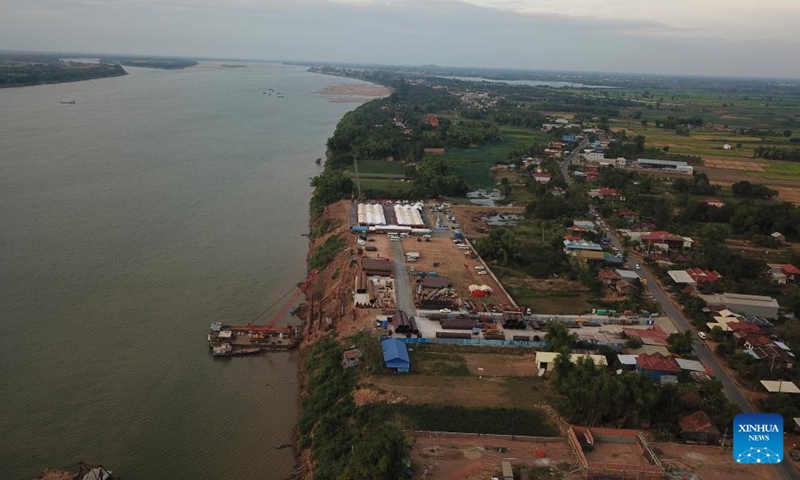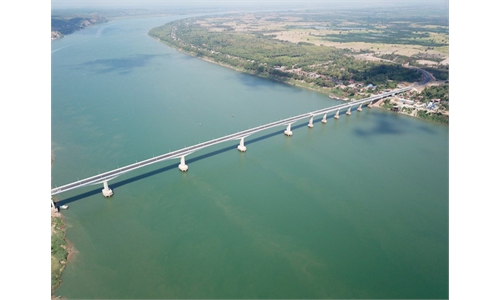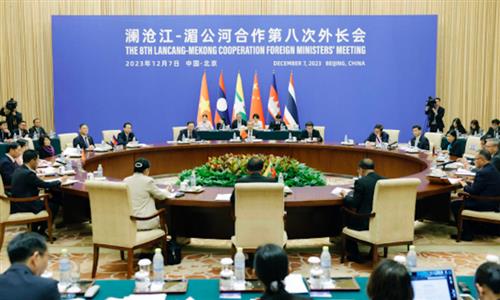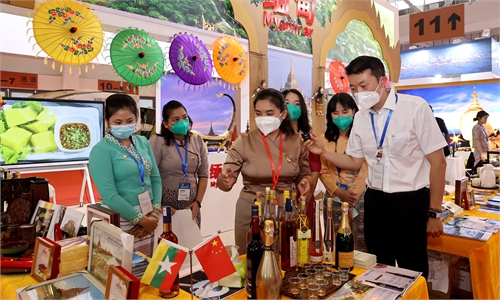LMC members unveil five-year economic cooperation plan, aiming to strengthen sub-regional economic integration: MOFCOM

This aerial photo taken on Jan. 1, 2023 shows the construction site of a China-funded bridge in Kratie province, Cambodia. Cambodia on Monday broke ground for the construction of a bridge across the Mekong River here in the country's northeastern part, with funds from China. (Photo by Van Pov/Xinhua)
During the just concluded fourth Lancang-Mekong Cooperation (LMC) Leaders’ Meeting, the economic and trade departments of the six member countries jointly approved a five-year plan (2023-2027) on cross-border economic cooperation, aiming to strengthen sub-regional economic integration and development, China’s Ministry of Commerce (MOFCOM) said on Tuesday.
According to the plan, LMC members will strategize on trade and investment, cross-border logistics, e-commerce, industrial park construction, exhibitions and trade fairs, support for small and medium-sized enterprises, human resource development, and economic-technological exchanges, among other relevant aspects, MOFCOM said in a statement released on its website.
This holds great guiding significance for economic and trade cooperation among LMC countries, promising to elevate the level of cross-border economic collaboration among the members and further propel sub-regional economic integration and development, MOFCOM noted.
The LMC is a new type of sub-regional cooperative mechanism under which countries in the region engage in joint discussions, collaborative construction, and shared benefits. It identified connectivity, production capacity cooperation, cross-border economic cooperation, water resources, agriculture and poverty reduction as five key areas of cooperation.
Chinese Premier Li Qiang attended the fourth LMC Leaders' Meeting via videolink on Monday, together with leaders from Cambodia, Laos, Myanmar, Thailand and Vietnam, the five ASEAN member states that the Mekong River runs through.
During the meeting, Li called for deepening integrated development, and strengthen cooperation in economy, trade, production capacity, agriculture and intelligent manufacturing. He also called on all sides to promote green cooperation, fully respect the legitimate rights and interests of all countries in rational development and utilization of water resources, and accommodate each other's concerns.
The LMC is a highly dynamic region, with greater potential on the horizon. It explicitly sets the goal of building a community with a shared future for mankind, and advancing economic and trade cooperation will lay a crucial foundation for this goal, Zhou Shixin, a research fellow at Shanghai Institutes for International Studies, told the Global Times on Tuesday.
He noted that enhancing economic and trade cooperation is beneficial for the member countries, and these nations have demonstrated strong confidence and willingness to promote economic growth.
The LMC members enjoy favorable trade conditions, with the trade volume between these countries increasing from $5 billion in 1992 to $785 billion in 2021, according to media reports.
In 2022, China’s trade with other LMC countries stood at $416.7 billion, doubling compared to seven years ago, data from China’s Foreign Ministry showed.
China is the largest trading partner for Thailand, Myanmar, Vietnam, and Cambodia, and the second-largest trading partner for Laos.
LMC members have made meaningful progress in terms of enhancing connectivity over recent years. As of October 3, the China-Laos Railway has been in operation for 22 months, transporting a total of over 26.8 million tons of goods. Among these, the cross-border freight volume reached 5.5 million tons, and the variety of transported goods has expanded to over 2,700 different types, according to data from China Railway.
Moreover, 13 cross-border power interconnection channels have been established, facilitating partial grid interconnection between China and Vietnam, Laos, and Myanmar, according to media reports.
Experts noted that the cooperation potential among member countries is immense, particularly in the fields of agricultural product processing, agrochemicals, as well as in sectors such as petroleum, natural gas, energy, and information technology.



